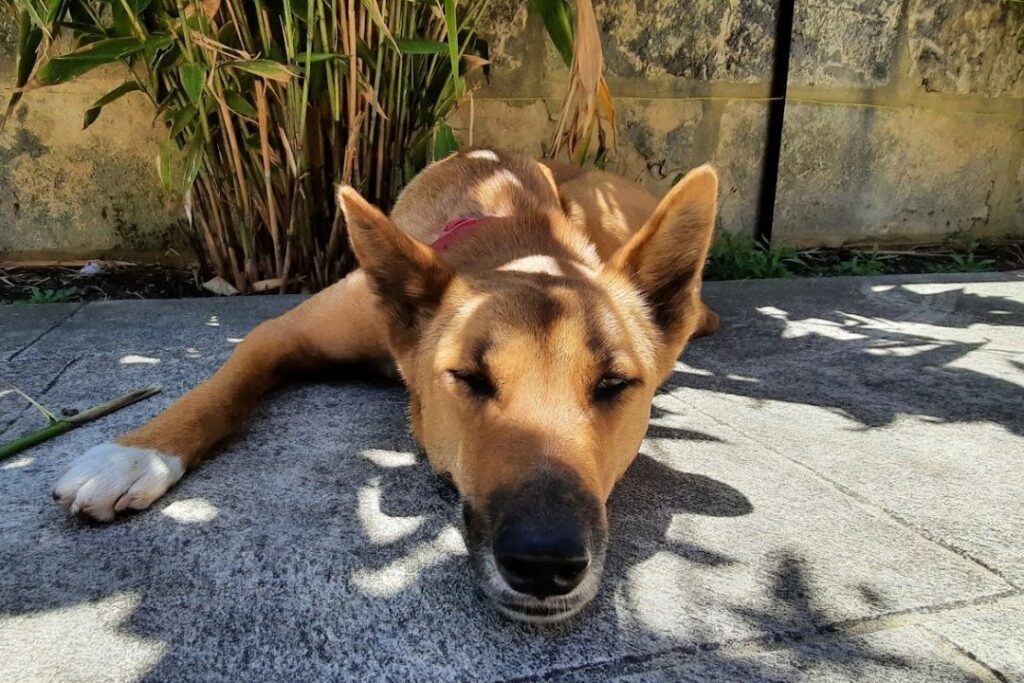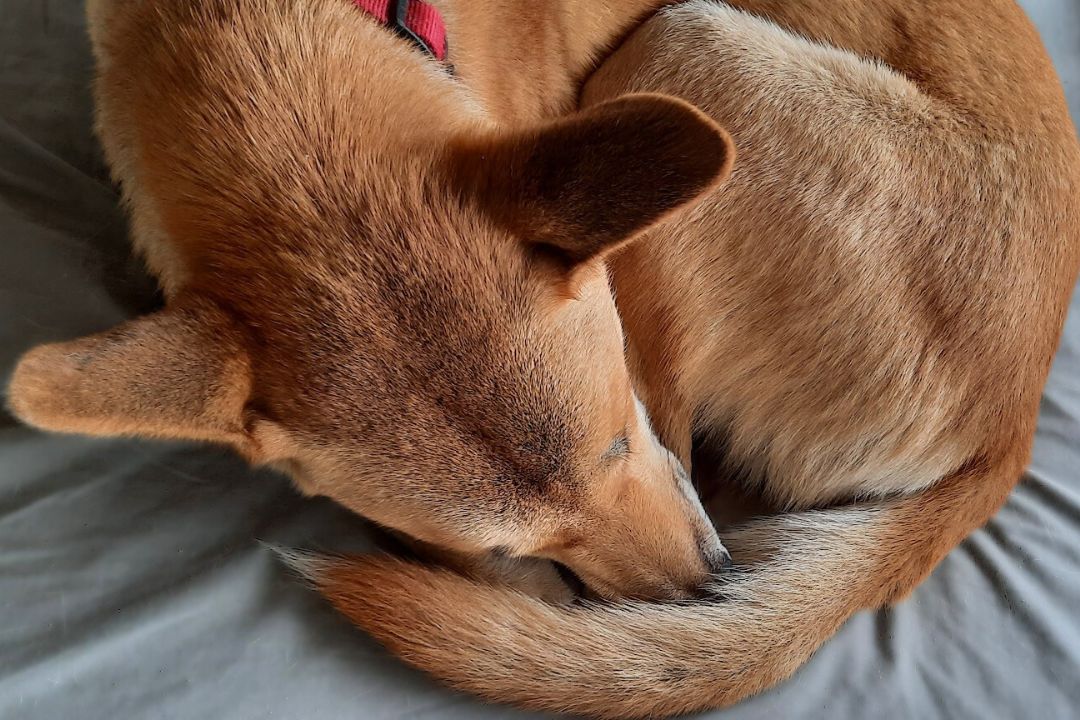Adopting a dingo can be a daunting endeavour. There’s a lot to think about to ensure your dingo settles in well at home and to ensure that you too settle into your new life.
We adopted two wild-born dingoes two years ago, both were orphaned as pups and both were in need of a permanent home. Below I’ll cover some of the necessities and also a few extra supplies or changes that can make dingo adoption a little bit easier.
Essential supplies when you adopt a dingo
These are the bare necessities if you’re adopting a dingo:
- Water bowl
- Food bowl
- A safe place to sleep
- Collar (Martingale)
- Leash (2 metres)
- Raw chicken or kangaroo (about 450g per dingo, per day)
Other supplies which can be very useful early on:
- Other sources of protein (eggs, sardines)
- Dried training treats (we use Love Em Air Dried Beef Liver)
- Low fat, grain-free kibble (we use Holistic Select Grain Free Salmon Anchovy Sardine)
Essential requirements when you adopt a dingo
If you’re thinking of adopting a dingo, there are essential property requirements. These will vary depending on your location — please check your state/territory and local council/shire laws for your specific requirements. I’m based in Western Australia.
High, secure, permanent fencing
The most essential requirement is secure fencing. Dingoes are known as escape artists. Dingoes have an incredible jumping ability, they can also squeeze through small spaces and have enviable joint dexterity.
Property requirements will vary slightly depending on the individual dingo, but generally, fencing must be at least 2 metres high or have a 45 degree return to prevent your dingo from jumping over your fence. If a return or vertical extension on your fence isn’t an option, you can also consider rollers on the top.
Fencing must be secure, with no gaps, and you’ll also need to ensure it’s relatively dig-proof. Examples include burying mesh horizontally along the fence line or having a deeper foundation for your fence.
Our property is enclosed by 1m high and 1m deep limestone blocks — this is quite common in Perth, where our blocks of land are often literally just sand. On top of the blocks we have a standard Colorbond fence. We live on a hill, so two sides of our property has fences about 3 metres high, while one side was only 2 metres. We added Colorbond fence extensions and a high gate on that side. All our external gates are key-locked, every single time, because dingoes know how to open latches!
Our dingoes can dig very well and very deep, so we keep an eye on our yard for any holes, and fill them if they’re near the fence. Sometimes we’ll encourage them to dig in a better spot by starting the digging in a more ideal spot.
Temporary fencing for your adopted dingo
It can take a while to get fences sorted, whether it be due to funds, supply or service availability. Pet rescue organisations and dingo rescue organisations can often be full, and they may need to find a home for dingoes quickly.
If you don’t have time to upgrade your fences straight away, a temporary solution is an electric fence. Not the kind used on farms where any touch causes a shock, but the kind that works with a collar. I’m aware that using an electric fence is not ideal, but they learn quickly and the shock is tolerable — we even tested it ourselves (obviously not recommended!). Although it’s not the best solution, it’s better than the possible alternatives, which are euthanasia, escape and potential injury to themselves, other animals or people.
We used a fence from our local pet store. It came with white flags to help our dingoes identify how far they needed to stay from the barrier. Each of ours were zapped once or twice and after that they knew where was safe and where was not. If you use a fence like this, when your dingo first wears the collar, it’s important you’re not outside with them, so they don’t associate you with the shock.
After a few months, we left the fence up but turned it off, and they stayed away from the boundary. We gradually phased out their collars and took the electric barrier fence down.

Tips to help you stay sane when you adopt a dingo
1. Use safety gates
Consider buying child-safety gates from Kmart, Bunnings or your local baby supply store. We use two safety gates, one in each hallway. We did this for three reasons:
- Minimise cleaning. Preventing fur build up on our carpet and bedding has made life a lot easier.
- Reduce the risk of escape. It’s not likely our dingoes would run out the front door, but having a safety gate near the front door gives us peace of mind and also makes it easier when we’re unloading groceries.
- Peace of mind. Our dingoes don’t really steal or chew our personal belongings, but having the safety gates means we can reduce the temptation for them, preventing access to soft toys, shoes etc.
Child-safety gates are quite low (about 900mm high), so they’re not foolproof, more of a deterrent. They definitely have the ability to jump over the gates or push them down, just as Jalba did when our security door was installed. If we don’t close the gates properly, they like to nudge the gates open with their noses and have a good sniff around our rooms (so cute!).
2. Consider replacing door handles with door knobs
When we built our house, we chose these beautiful silver door handles. When Rusty came home, he was very attached to hubby, and Rusty kept opening the hallway door so he could go find him. So, off we went to Bunnings to buy a bunch of door knobs.
3. Set clear boundaries
Dingoes jumping on people
When dingoes play, they can be quite strong, so we’ve made it clear to ours that jumping on us is a no-go, unless it’s hubby or our oldest child, because they don’t mind it. Thankfully Rusty no longer parkours off me, but when we arrive home sometimes, with gentleness and affection, he stands on his back legs so we can hold his front paws for a moment — super sweet!
Dingoes on the kitchen bench and table
In the very early days, Rusty enjoyed jumping onto the dining table and the kitchen bench to search for food or simply lie down. Very cute but that’s a big no from me. To counter this, we:
- Always ensure no food is left on the bench — sometimes we leave food up there but generally keep it supervised and only for short periods.
- Rewarded Rusty and Jalba for keeping four paws on the ground, outside of the kitchen. We did this by asking them to sit and rewarding them with kibble, liver treats, little pieces of cheese or chicken. We still do this today.
- Placed foil on the bench. I only had to do this once and it gave Rusty a fright, it was just like those videos of cats jumping onto foil.
Dingoes in the kitchen
Dingoes in the kitchen were dangerous, not just because we could trip on them or they could get burnt, but because they were starting to view it as their space, which it wasn’t.
When it comes to food, dingoes can become a little competitive and defensive, and we found that both dingoes were nipping our children occasionally, but only in the kitchen. It may have been because our dingoes felt they were competing with our children for food, or because they were trying to steal food. Either way, nipping our children was not okay.
A child-safety gate might work in some kitchens, but not ours. After a bit of brainstorming with dad, we got a shelf on wheels from Officeworks, which now acts as a physical barrier to the kitchen. We lock the wheel on one end and open and close the trolley at the other end to enter the kitchen.
It put an end to the nipping instantly. Our dingoes have the ability to jump over it or open the gate if they really want to, but generally, they don’t.
4. Batten down the hatches
Before we adopted our dingoes, our main living area was often littered with our youngest child’s shoes and socks or occasionally hubby’s camping equipment. One of the best side benefits of having dingoes is that now, nobody leaves anything lying around that the dingoes can chew.
We also packed our bookshelf tightly and added fabric boxes to protect some of the books. There are still plenty of our belongings within reach, such as on my desk or the top of the bookshelf, but they don’t seem to take any of those things.
We keep a steady supply of recyclable material for them to chew: cereal boxes, egg cartons, tissue boxes, wrapping paper tubes etc. Rusty’s quite funny — if he breaks into the kitchen he usually shops for a cardboard box and runs outside with it, ignoring all the plastic food containers and lunch bags.

5. Find the right trainer
Dingoes have unique characteristics and the right trainer will be open to understanding dingoes and their unique needs. If you can’t find a trainer who has experience working with dingoes, consider a trainer who has experience working with anxious or reactive dogs or dogs with a high prey drive.
The first dog trainer we worked with had some great advice for our first session, but unfortunately wasn’t able to provide solid advice when it came to reactivity.
The second dog trainer we worked with was Jacqui from Dog Sense Training and Behaviour and she gave us some great tips to get started with leash pulling and reactivity.
6. Give yourself some grace
Adopting a dingo is no easy feat and by adopting a dingo, you’re doing a great, big, gracious thing.
Remember to be patient with not only your dingo, but yourself. There will be easy days, hard days and everything in between. If you need support, consider contacting your adoption agency or joining one of the many dingo Facebook groups.
More information about adopting a dingo
Remember that the information above is a first-person perspective; these are the things that we do, we are not dingo experts, we are dingo guardians.
Please also remember there’s a lot of inaccurate information on the web, so choose your sources carefully (mine included!) and with a critical eye. Please feel welcome to contact me or comment below about our dingoes, my writing or to share what you do with your dingo.
Here are useful links if you’re thinking of adopting a dingo:
- Where to adopt a dingo in Australia
- Dingo Den (NSW) https://www.dingoden.net/
- Australian Dingo Foundation (Victoria) https://dingofoundation.org/
- WA Dingo Association (WA) https://www.wadingo.com/

Thank you for your Dingo reports. A small dingo puppy wandered into our yard (almost expired from starvation). Luckily I have a fantastic country vet who helped me get him back on track. The dingoes in our area have a bounty on their heads and I have no doubt his parents were murdered or baited.
He is now approx 7 months old and has bonded with our family and our farm dog. It has been a challenge to train him, but we are learning as we go. I can walk him around the farm off lead, until he sees a roo. Then all recall goes out the door 😄. He is kind with our mini ponies, the dogs next door and us. He doesn’t like strangers at all and gets very anxious. Whenever he does get out of the house yard, he comes home after a lizard chase and long grass romp.
It has been great to read about your experiences, as ours are similar (murdered socks, shoes etc..).
Here’s to helping dingoes!
Cheers
Sharon
Hi Sharon, it’s wonderful to hear from you. I’m so glad to hear your dingo has settled in with you and your family — what a wonderful life for him on your farm! Adopting dingoes is certainly a learning experience 🙂